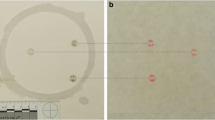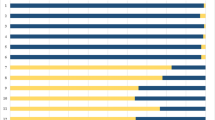Abstract
The polyvinylalcohol (PVAL) method for sampling gunshot residues from the hands was used in 30 investigations involving 22 suicides, 3 accidents and 5 homicides. In these cases 16 pistols, 7 revolvers, 2 shotguns and 2 rifles had been used. The small calibres (.22 lr to 7.65 mm) represented 75% of the arms. In two cases lead-free primers had deposited zink-containing residues. PVAL gloves were examined by microradiography and chemographical analysis. The PVAL method was successful in 29 cases and assisted in the majority of cases to reconstruct the position of the arm during shooting. Additionally, 16 other pairs of hands were treated with adhesive films. In 6 cases of suicide the films showed lead-containing traces and gave evidence of shooting. It was also possible to reconstruct an accident with lead-free ammunition. In 3 out of the 9 cases of criminal shooting the adhesive films did not contain gunshot residues. The amount of traces on the films did not reach the yield of traces fixed by PVAL. PVAL gloves showed better and more stable staining results. The adhesive films did not work if there was too much blood on the hands. The staining results of these bloody films were not satisfactory.
Zusammenfassung
Die Polyvinylalkoholmethode (PVAL) zur Sicherung von Schußrückständen an den Händen wurde in 30 Ermittlungsverfahren angewandt. Es handelte sich um 22 Suizide, 3 Unfälle und 5 Tötungsdelikte. In diesen Fällen waren 16 Pistolen, 7 Revolver, 2 Flinten und 2 Büchsen benutzt worden. In 75% der Waffen handelte es sich um kleine Kaliber (.22 lr bis 7,65 mm). In zwei Fällen hatten bleifreie Anzündsätze zinkhaltige Spuren verursacht. Die PVAL-Handschuhe wurden mikroradiographisch und chemographisch untersucht. Die PVAL-Methode führte in 29 Fällen zum Erfolg und half in der Mehrzahl der Fälle, die Haltung der Waffe bei Schußabgabe zu rekonstruieren. Außerdem wurden 16 weitere Handpaare mit Klebefolien behandelt. In 6 Suizidfällen wiesen die Folien bleihaltige Spuren auf und bewiesen die Schußabgabe. Ein Unfall mit bleifreier Munition konnte ebenfalls rekonstruiert werden. In 3 von 9 Fällen von kriminellem Schußwaffengebrauch enthielten die Folien keine Schußrückstände. Das Spurenaufkommen auf den Folien erreichte nicht die Ausbeute im PVAL. PVAL-Handschuhe zeigten bessere und beständigere Färberesultate. Folien versagten, wenn sich zuviel Blut an den Händen befand. Die Färbeergebnisse der blutigen Folienabzüge waren unzureichend.
Similar content being viewed by others
Author information
Authors and Affiliations
Additional information
Eingegangen: 23. Dezember 1996 / Angenommen: 29. Januar 1997
Rights and permissions
About this article
Cite this article
Schyma, C., Schyma, P. Der praktische Schußhandnachweis Die PVAL-Methode im Vergleich zu Abzügen mit Folie. Rechtsmedizin 7, 152–156 (1997). https://doi.org/10.1007/PL00004141
Issue Date:
DOI: https://doi.org/10.1007/PL00004141




